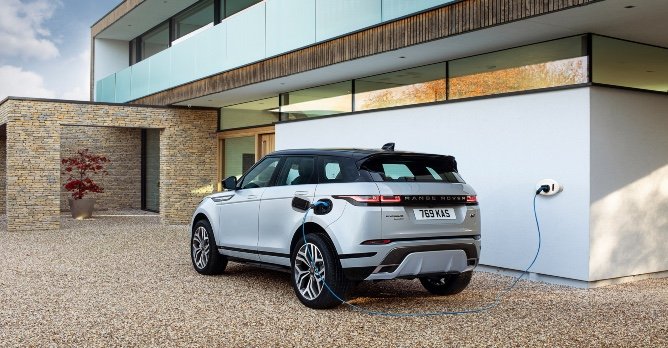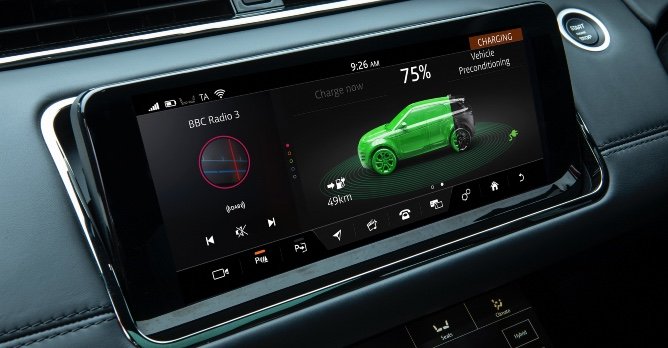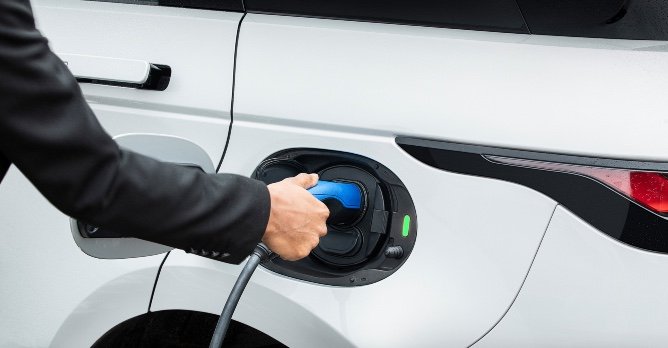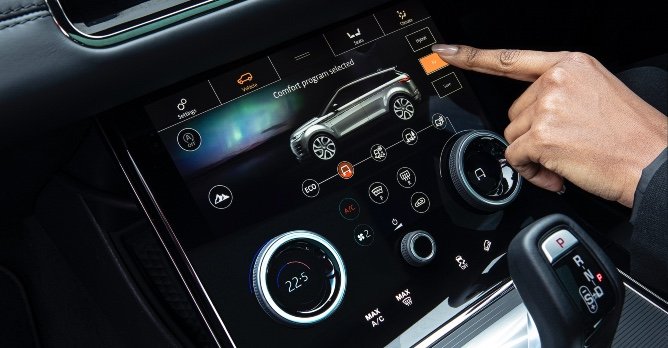Land Rover develops three-cylinder plug-in hybrids
28 Apr 2020|346 views
The new Range Rover Evoque and Land Rover Discovery Sport premium compact SUVs are now available with Plug-in Hybrid Electric Vehicle (PHEV) technology, delivering the performance, refinement and capability customers expect together with an electric-only range of up to 66km and CO2 emissions as low as 32g/km.
Badged P300e, both the new Range Rover Evoque and Land Rover Discovery Sport plug-in hybrids are based on Land Rover's state-of-the-art Premium Transverse architecture, which was designed to support electrification while maintaining Land Rover's signature off-road capability.
The new plug-in hybrid P300e models will join the existing 48V mild-hybrid SUVs, offering sustainable performance by combining a 197bhp 1.5-litre three-cylinder Ingenium petrol engine with a 108bhp electric motor integrated into the rear axle powered by a 15kWh lithium-ion battery located below the rear seats.
Performance and capability are uncompromised with an acceleration of zero to 100km/h in just 6.4 seconds in the Range Rover Evoque. Meanwhile, the Discovery Sport completes the same sprint in 6.6 seconds. Both can reach speeds of up to 135km/h using electric power alone.
Efficiency is remarkable as the Range Rover Evoque P300e emits just 32g/km of CO2 under the Worldwide harmonised Light vehicle Test Procedure and has an all-electric, zero tailpipe emission range of up to 66km, with fuel economy of 1.4L/100km. The Discovery Sport P300e can travel up to 62km using all-electric power and delivers fuel economy of 1.6L/100km. Thanks to its electrified technology, the Discovery Sport P300e produces exceedingly low CO2 emissions of only 36g/km.
The Electric Rear Axle Drive (ERAD) is powered by a compact 15kWh lithium-ion battery made up of 84 prismatic cells, arranged in seven 50Ah modules of 12, with a 6mm-thick steel undertray that protects the battery without compromising the vehicles' hallmark all-terrain capability.
The advanced ERAD features a light, compact and efficient synchronous permanent magnet motor. To optimise package space, the driveshafts are concentric with the motor and single-speed transmission, while the inverter is also integrated within the ERAD casing.
Packaged next to this is the Belt-integrated Starter Generator (BiSG) Inverter which, through intelligent electrical management, can send recuperation energy to the high-voltage battery for storage to use later or for immediate redeployment to support full all-wheel drive capability. A new brake-by-wire system replaces the traditional brake vacuum servo, and seamlessly blends regenerative and friction braking to provide a consistent and precise pedal feel. The system can deliver up to 0.2g of deceleration under regenerative braking, maximising energy efficiency by using the vehicles' kinetic energy to recharge the battery on the overrun.
The new PHEV models are available with a Type 2 Home Charging Cable that fully charge the vehicle in six hours 42 minutes, perfect for overnight charging. For faster charging, the Type 3 Charging Cable plugs into a 7kW AC domestic wall box or AC public charge points which charges from zero to 80% in just one hour and 24 minutes.
The quickest charge times are achieved using the growing public charging network of 32kW DC charge points takes just 30 minutes to go from zero to 80%. The charge port flap is located on the rear fender, on the opposite side of the vehicle to the fuel filler flap.
Customers can stay connected to the Evoque and Discovery Sport PHEV via Land Rover's intelligent InControl Remote smartphone application. Whether at home or out and about, the app allows customers to monitor the vehicle's charge status, ready the vehicle for the journey ahead or even set a charging timer to take advantage of off-peak energy tariffs. Owners can automatically pre-condition the battery and cabin temperature before starting a journey using mains power when the vehicle is plugged in rather than drawing energy from the battery when you start driving, maximising range and enhancing occupant comfort.
A state-of-the-art 1.5-litre three-cylinder petrol engine is at the heart of the new PHEVs - the latest member of the modular, flexible Ingenium engine family, which now has three, four and six-cylinder variants.
The lightweight aluminium engine, 37kg lighter than the four-cylinder, achieves exceptionally low levels of friction, which contributes to its excellent efficiency. The exhaust manifold is integrated into the aluminium cylinder head, contributing to the rapid warm-up times and minimising the distance from the exhaust ports to the turbocharger's turbine wheel for improved responsiveness.
The three-cylinder configuration delivers a better flow of exhaust gases, ensuring the turbine wheel delivers boost pressure almost instantaneously.
A highly efficient Water-cooled Air Charge Cooler means the density of air being drawn into the combustion chambers remains high, further enhancing performance and efficiency across the engine's operating range. The three-cylinder, like the four-cylinder mild hybrid models, also features a BISG unit. This works alongside the ERAD to deliver regenerative braking, recharging the battery on overrun, and also enables smoother, quieter and faster stop-start operation than a traditional starter motor.
The new Range Rover Evoque and Land Rover Discovery Sport premium compact SUVs are now available with Plug-in Hybrid Electric Vehicle (PHEV) technology, delivering the performance, refinement and capability customers expect together with an electric-only range of up to 66km and CO2 emissions as low as 32g/km.
Badged P300e, both the new Range Rover Evoque and Land Rover Discovery Sport plug-in hybrids are based on Land Rover's state-of-the-art Premium Transverse architecture, which was designed to support electrification while maintaining Land Rover's signature off-road capability.
The new plug-in hybrid P300e models will join the existing 48V mild-hybrid SUVs, offering sustainable performance by combining a 197bhp 1.5-litre three-cylinder Ingenium petrol engine with a 108bhp electric motor integrated into the rear axle powered by a 15kWh lithium-ion battery located below the rear seats.
Performance and capability are uncompromised with an acceleration of zero to 100km/h in just 6.4 seconds in the Range Rover Evoque. Meanwhile, the Discovery Sport completes the same sprint in 6.6 seconds. Both can reach speeds of up to 135km/h using electric power alone.
Efficiency is remarkable as the Range Rover Evoque P300e emits just 32g/km of CO2 under the Worldwide harmonised Light vehicle Test Procedure and has an all-electric, zero tailpipe emission range of up to 66km, with fuel economy of 1.4L/100km. The Discovery Sport P300e can travel up to 62km using all-electric power and delivers fuel economy of 1.6L/100km. Thanks to its electrified technology, the Discovery Sport P300e produces exceedingly low CO2 emissions of only 36g/km.
The Electric Rear Axle Drive (ERAD) is powered by a compact 15kWh lithium-ion battery made up of 84 prismatic cells, arranged in seven 50Ah modules of 12, with a 6mm-thick steel undertray that protects the battery without compromising the vehicles' hallmark all-terrain capability.
The advanced ERAD features a light, compact and efficient synchronous permanent magnet motor. To optimise package space, the driveshafts are concentric with the motor and single-speed transmission, while the inverter is also integrated within the ERAD casing.
Packaged next to this is the Belt-integrated Starter Generator (BiSG) Inverter which, through intelligent electrical management, can send recuperation energy to the high-voltage battery for storage to use later or for immediate redeployment to support full all-wheel drive capability. A new brake-by-wire system replaces the traditional brake vacuum servo, and seamlessly blends regenerative and friction braking to provide a consistent and precise pedal feel. The system can deliver up to 0.2g of deceleration under regenerative braking, maximising energy efficiency by using the vehicles' kinetic energy to recharge the battery on the overrun.
The new PHEV models are available with a Type 2 Home Charging Cable that fully charge the vehicle in six hours 42 minutes, perfect for overnight charging. For faster charging, the Type 3 Charging Cable plugs into a 7kW AC domestic wall box or AC public charge points which charges from zero to 80% in just one hour and 24 minutes.
The quickest charge times are achieved using the growing public charging network of 32kW DC charge points takes just 30 minutes to go from zero to 80%. The charge port flap is located on the rear fender, on the opposite side of the vehicle to the fuel filler flap.
Customers can stay connected to the Evoque and Discovery Sport PHEV via Land Rover's intelligent InControl Remote smartphone application. Whether at home or out and about, the app allows customers to monitor the vehicle's charge status, ready the vehicle for the journey ahead or even set a charging timer to take advantage of off-peak energy tariffs. Owners can automatically pre-condition the battery and cabin temperature before starting a journey using mains power when the vehicle is plugged in rather than drawing energy from the battery when you start driving, maximising range and enhancing occupant comfort.
A state-of-the-art 1.5-litre three-cylinder petrol engine is at the heart of the new PHEVs - the latest member of the modular, flexible Ingenium engine family, which now has three, four and six-cylinder variants.
The lightweight aluminium engine, 37kg lighter than the four-cylinder, achieves exceptionally low levels of friction, which contributes to its excellent efficiency. The exhaust manifold is integrated into the aluminium cylinder head, contributing to the rapid warm-up times and minimising the distance from the exhaust ports to the turbocharger's turbine wheel for improved responsiveness.
The three-cylinder configuration delivers a better flow of exhaust gases, ensuring the turbine wheel delivers boost pressure almost instantaneously.
A highly efficient Water-cooled Air Charge Cooler means the density of air being drawn into the combustion chambers remains high, further enhancing performance and efficiency across the engine's operating range. The three-cylinder, like the four-cylinder mild hybrid models, also features a BISG unit. This works alongside the ERAD to deliver regenerative braking, recharging the battery on overrun, and also enables smoother, quieter and faster stop-start operation than a traditional starter motor.
Latest COE Prices
July 2025 | 1st BIDDING
NEXT TENDER: 23 Jul 2025
CAT A$101,102
CAT B$119,600
CAT C$66,689
CAT E$118,500
View Full Results Thank You For Your Subscription.



























